2016 NISSAN 370Z ROADSTER warning
[x] Cancel search: warningPage 1 of 27
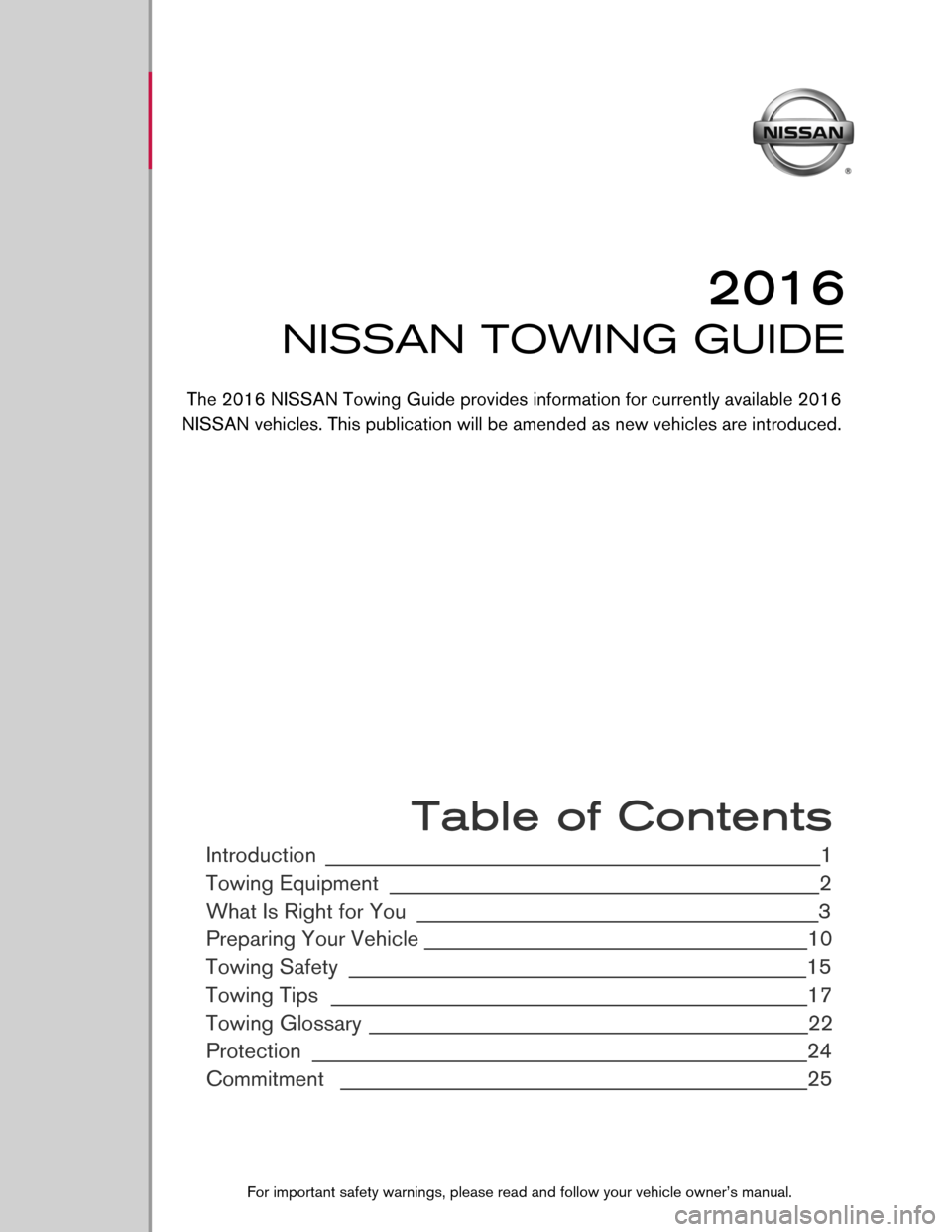
9
2016
NISSAN TOWING GUIDE
Table of Contents
Introduction _____________________________________________________1
Towing Equipment
______________________________________________2
What Is Right for You
___________________________________________3
Preparing Your Vehicle
_________________________________________10
Towing Safety
_________________________________________________15
Towing Tips
___________________________________________________17
Towing Glossary
_______________________________________________22
Protection
_____________________________________________________24
Commitment
__________________________________________________25
The 2016 NISSAN Towing Guide provides information for currently available 2016
NISSAN vehicles. This publication will be amended as new vehicles are introduced.
For important safety warnings, please read and follow your vehicle owner’s manual.
Page 3 of 27
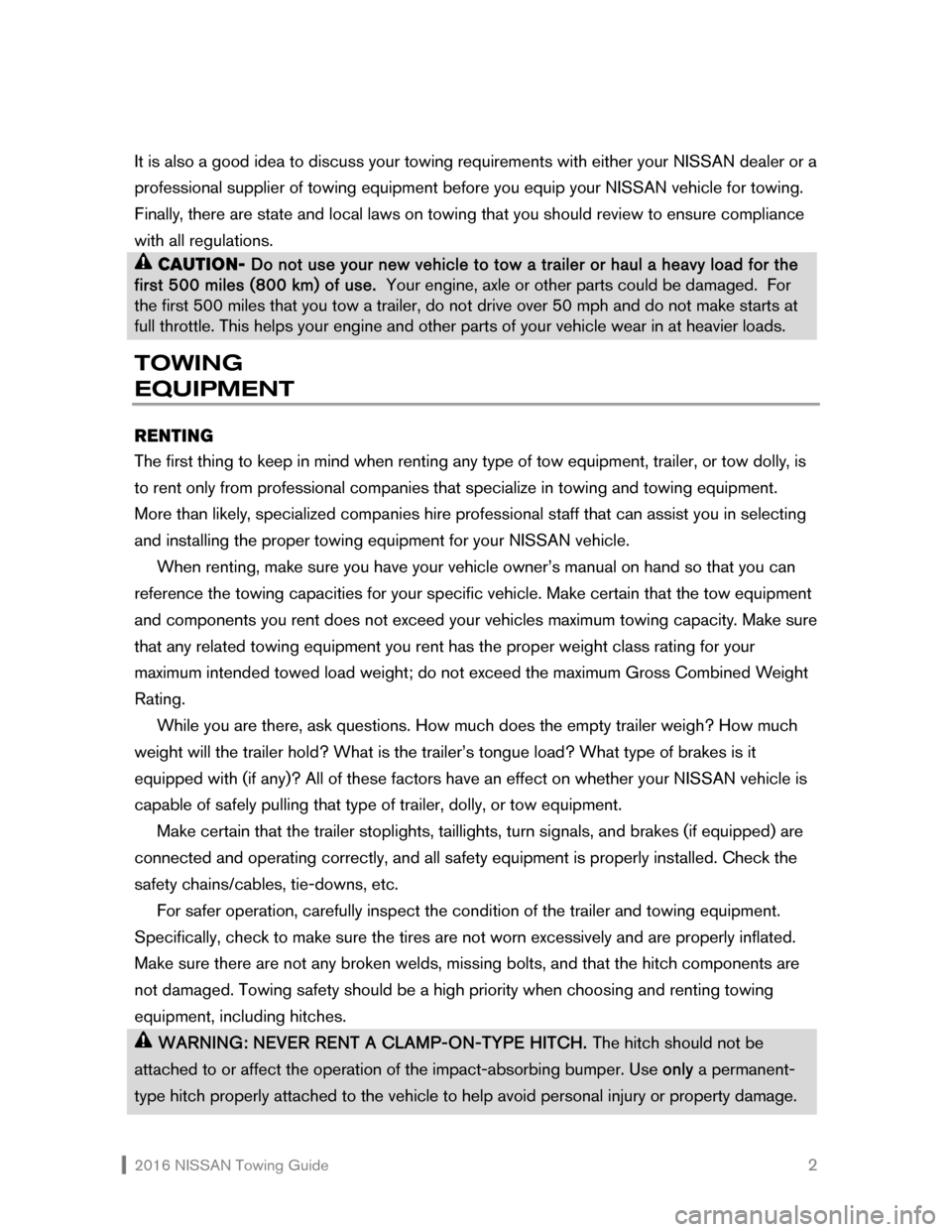
2016 NISSAN Towing Guide 2
It is also a good idea to discuss your towing requirements with either your NISSAN dealer or a
professional supplier of towing equipment before you equip your NISSAN vehicle for towing.
Finally, there are state and local laws on towing that you should review to ensure compliance
with all regulations.
CAUTION- Do not use your new vehicle to tow a trailer or haul a heavy load for the
first 500 miles (800 km) of use. Your engine, axle or other parts could be damaged. For
the first 500 miles that you tow a trailer, do not drive over 50 mph and do not make starts at
full throttle. This helps your engine and other parts of your vehicle wear in at heavier loads.
TOWING
EQUIPMENT
RENTING
The first thing to keep in mind when renting any type of tow equipment, trailer, or tow dolly, is
to rent only from professional companies that specialize in towing and towing equipment.
More than likely, specialized companies hire professional staff that can assist you in selecting
and installing the proper towing equipment for your NISSAN vehicle.
When renting, make sure you have your vehicle owner’s manual on hand so that you can
reference the towing capacities for your specific vehicle. Make certain that the tow equipment
and components you rent does not exceed your vehicles maximum towing capacity. Make sure
that any related towing equipment you rent has the proper weight class rating for your
maximum intended towed load weight; do not exceed the maximum Gross Combined Weight
Rating.
While you are there, ask questions. How much does the empty trailer weigh? How much
weight will the trailer hold? What is the trailer’s tongue load? What type of brakes is it
equipped with (if any)? All of these factors have an effect on whether your NISSAN vehicle is
capable of safely pulling that type of trailer, dolly, or tow equipment.
Make certain that the trailer stoplights, taillights, turn signals, and brakes (if equipped) are
connected and operating correctly, and all safety equipment is properly installed. Check the
safety chains/cables, tie-downs, etc.
For safer operation, carefully inspect the condition of the trailer and towing equipment.
Specifically, check to make sure the tires are not worn excessively and are properly inflated.
Make sure there are not any broken welds, missing bolts, and that the hitch components are
not damaged. Towing safety should be a high priority when choosing and renting towing
equipment, including hitches.
WARNING: NEVER RENT A CLAMP-ON-TYPE HITCH. The hitch should not be
attached to or affect the operation of the impact-absorbing bumper. Use only a permanent-
type hitch properly attached to the vehicle to help avoid personal injury or property damage.
Page 4 of 27
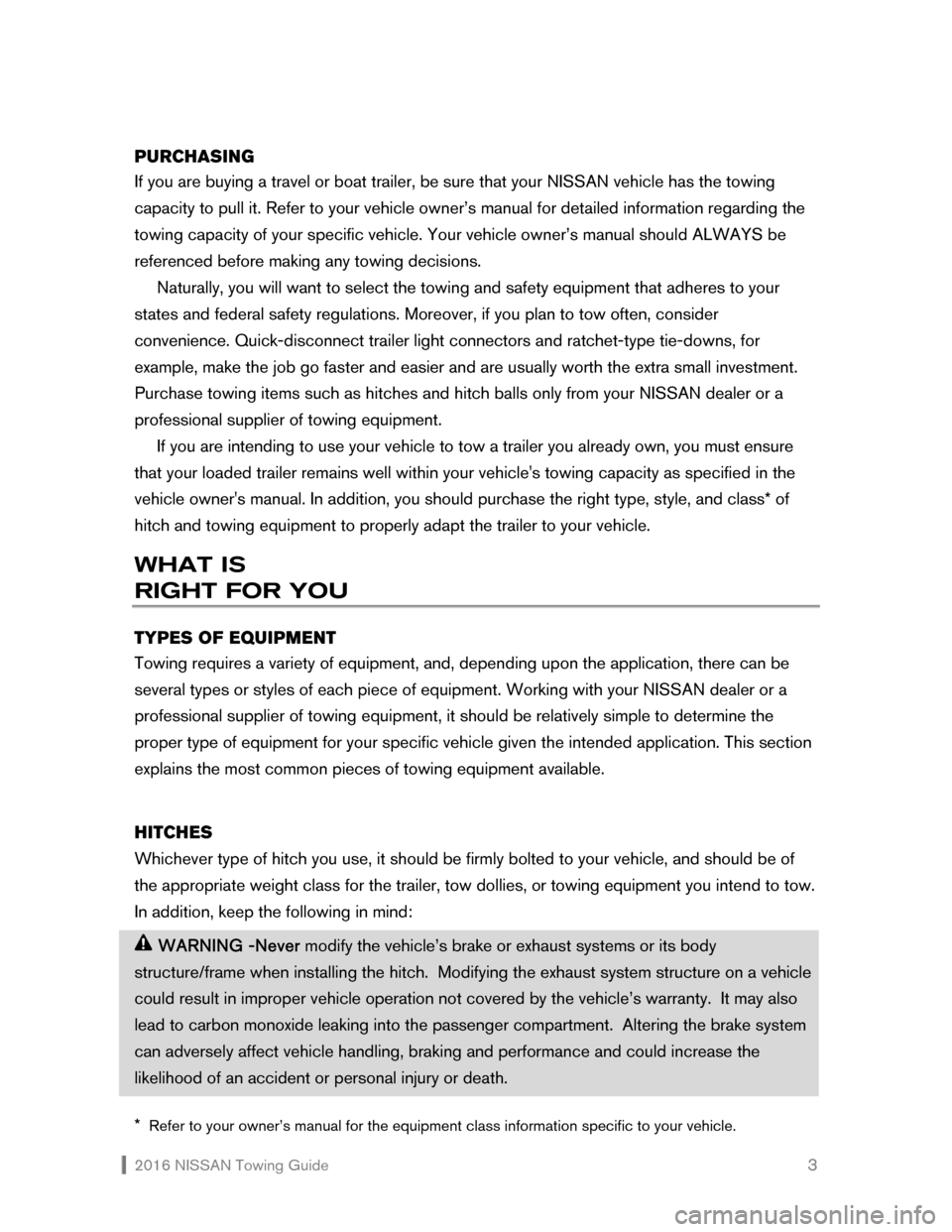
2016 NISSAN Towing Guide 3
PURCHASING
If you are buying a travel or boat trailer, be sure that your NISSAN vehicle has the towing
capacity to pull it. Refer to your vehicle owner’s manual for detailed information regarding the
towing capacity of your specific vehicle. Your vehicle owner’s manual should ALWAYS be
referenced before making any towing decisions.
Naturally, you will want to select the towing and safety equipment that adheres to your
states and federal safety regulations. Moreover, if you plan to tow often, consider
convenience. Quick-disconnect trailer light connectors and ratchet-type tie-downs, for
example, make the job go faster and easier and are usually worth the extra small investment.
Purchase towing items such as hitches and hitch balls only from your NISSAN dealer or a
professional supplier of towing equipment.
If you are intending to use your vehicle to tow a trailer you already own, you must ensure
that your loaded trailer remains well within your vehicle's towing capacity as specified in the
vehicle owner's manual. In addition, you should purchase the right type, style, and class* of
hitch and towing equipment to properly adapt the trailer to your vehicle.
WHAT IS
RIGHT FOR YOU
TYPES OF EQUIPMENT
Towing requires a variety of equipment, and, depending upon the application, there can be
several types or styles of each piece of equipment. Working with your NISSAN dealer or a
professional supplier of towing equipment, it should be relatively simple to determine the
proper type of equipment for your specific vehicle given the intended application. This section
explains the most common pieces of towing equipment available.
HITCHES
Whichever type of hitch you use, it should be firmly bolted to your vehicle, and should be of
the appropriate weight class for the trailer, tow dollies, or towing equipment you intend to tow.
In addition, keep the following in mind:
WARNING -Never modify the vehicle’s brake or exhaust systems or its body
structure/frame when installing the hitch. Modifying the exhaust system structure on a vehicle
could result in improper vehicle operation not covered by the vehicle’s warranty. It may also
lead to carbon monoxide leaking into the passenger compartment. Altering the brake system
can adversely affect vehicle handling, braking and performance and could increase the
likelihood of an accident or personal injury or death.
* Refer to your owner’s manual for the equipment class information specific to your vehicle.
Page 6 of 27
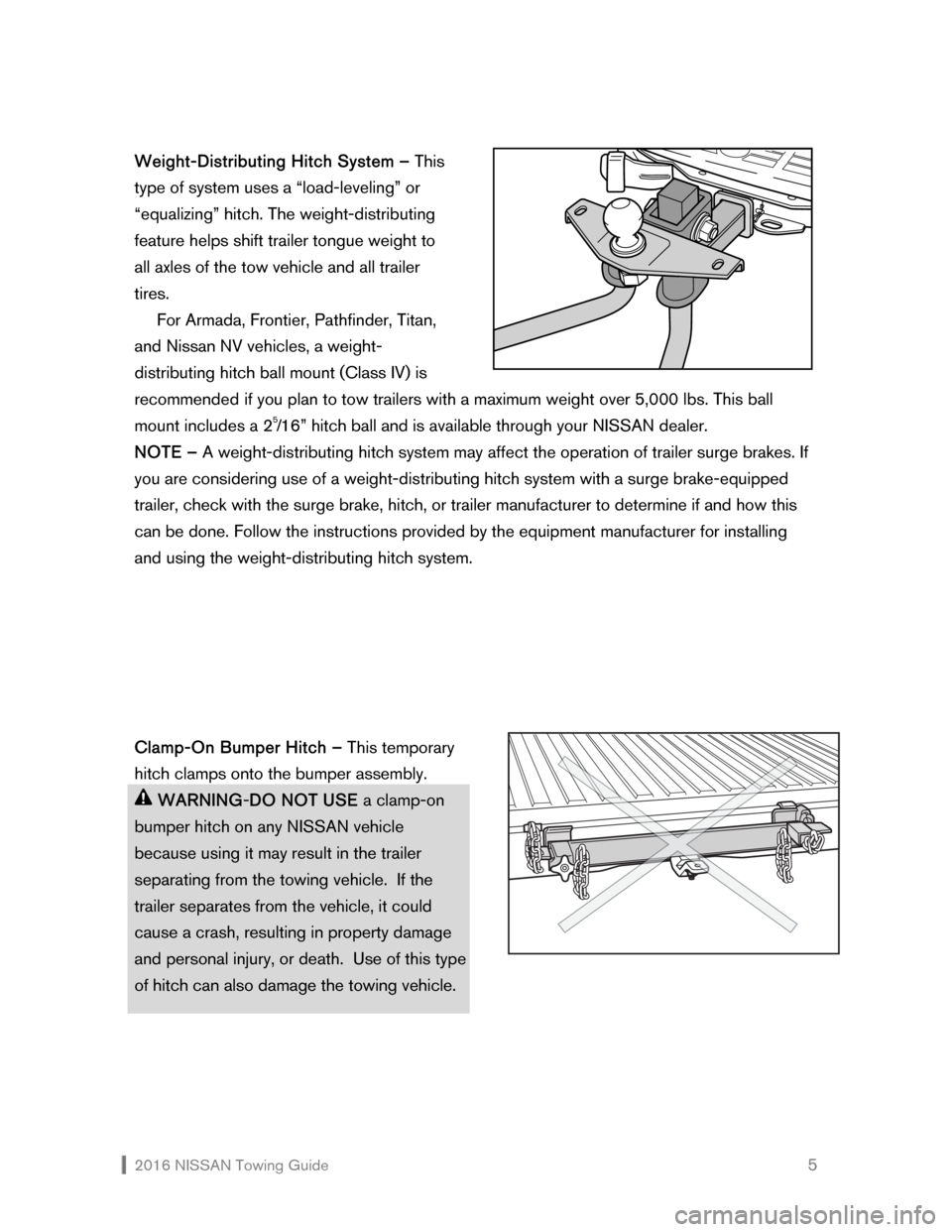
2016 NISSAN Towing Guide 5
Weight-Distributing Hitch System – This
type of system uses a “load-leveling” or
“equalizing” hitch. The weight-distributing
feature helps shift trailer tongue weight to
all axles of the tow vehicle and all trailer
tires.
For Armada, Frontier, Pathfinder, Titan,
and Nissan NV vehicles, a weight-
distributing hitch ball mount (Class IV) is
recommended if you plan to tow trailers with a maximum weight over 5,000 lbs. This ball
mount includes a 2
5/16” hitch ball and is available through your NISSAN dealer.
NOTE – A weight-distributing hitch system may affect the operation of trailer surge brakes. If
you are considering use of a weight-distributing hitch system with a surge brake-equipped
trailer, check with the surge brake, hitch, or trailer manufacturer to determine if and how this
can be done. Follow the instructions provided by the equipment manufacturer for installing
and using the weight-distributing hitch system.
Clamp-On Bumper Hitch – This temporary
hitch clamps onto the bumper assembly.
WARNING-DO NOT USE a clamp-on
bumper hitch on any NISSAN vehicle
because using it may result in the trailer
separating from the towing vehicle. If the
trailer separates from the vehicle, it could
cause a crash, resulting in property damage
and personal injury, or death. Use of this type
of hitch can also damage the towing vehicle.
Page 7 of 27
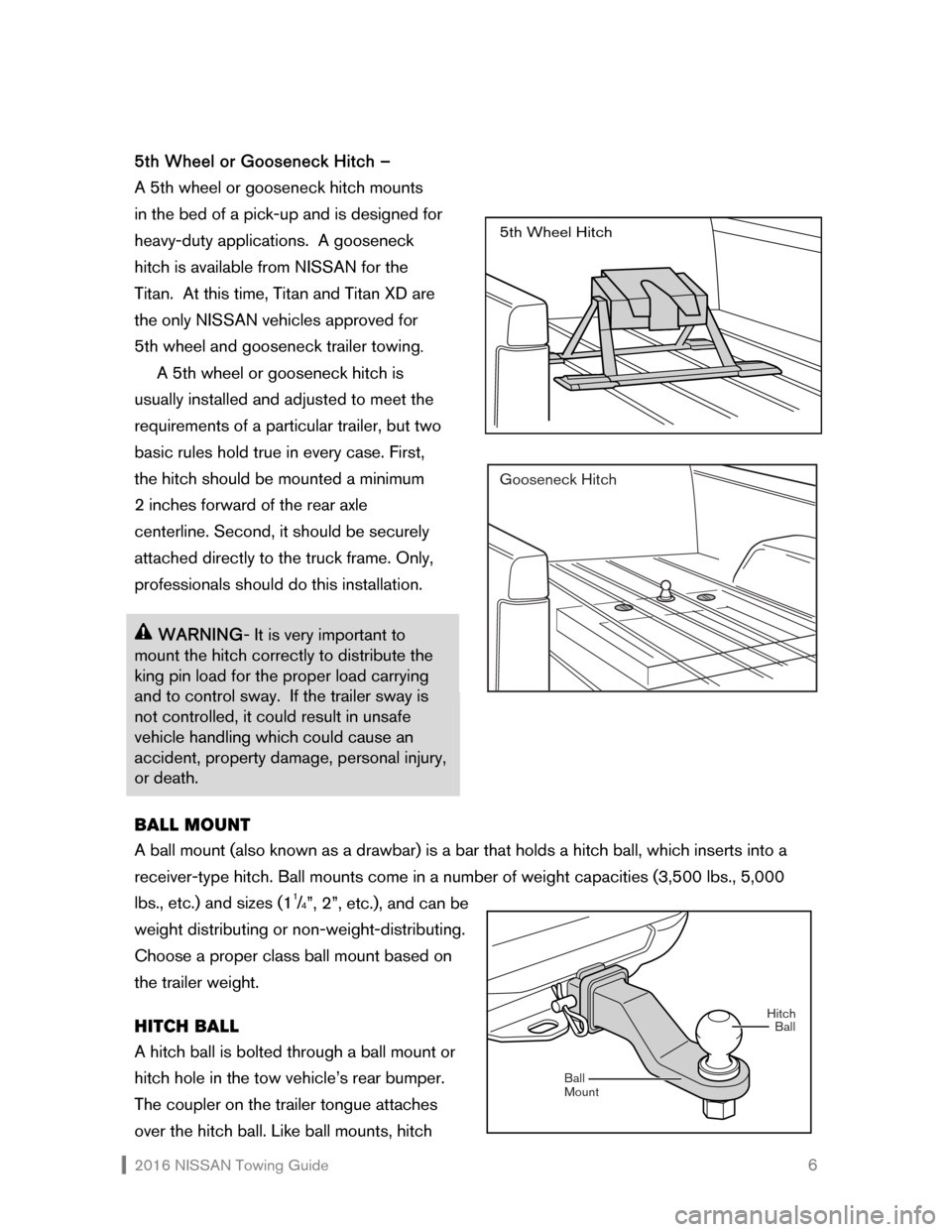
2016 NISSAN Towing Guide 6
5th Wheel or Gooseneck Hitch –
A 5th wheel or gooseneck hitch mounts
in the bed of a pick-up and is designed for
heavy-duty applications. A gooseneck
hitch is available from NISSAN for the
Titan. At this time, Titan and Titan XD are
the only NISSAN vehicles approved for
5th wheel and gooseneck trailer towing
.
A 5th wheel or gooseneck hitch is
usually installed and adjusted to meet the
requirements of a particular trailer, but two
basic rules hold true in every case. First,
the hitch should be mounted a minimum
2 inches forward of the rear axle
centerline. Second, it should be securely
attached directly to the truck frame. Only,
professionals should do this installation.
WARNING- It is very important to
mount the hitch correctly to distribute the
king pin load for the proper load carrying
and to control sway. If the trailer sway is
not controlled, it could result in unsafe
vehicle handling which could cause an
accident, property damage, personal injury,
or death.
BALL MOUNT
A ball mount (also known as a drawbar) is a bar that holds a hitch ball, which inserts into a
receiver-type hitch. Ball mounts come in a number of weight capacities (3,500 lbs., 5,000
lbs., etc.) and sizes (1
1/4”, 2”, etc.), and can be
weight distributing or non-weight-distributing.
Choose a proper class ball mount based on
the trailer weight.
HITCH BALL
A hitch ball is bolted through a ball mount or
hitch hole in the tow vehicle’s rear bumper.
The coupler on the trailer tongue attaches
over the hitch ball. Like ball mounts, hitch
5th Wheel Hitch
Gooseneck Hitch
Hitch
Mount BallBall
Page 9 of 27
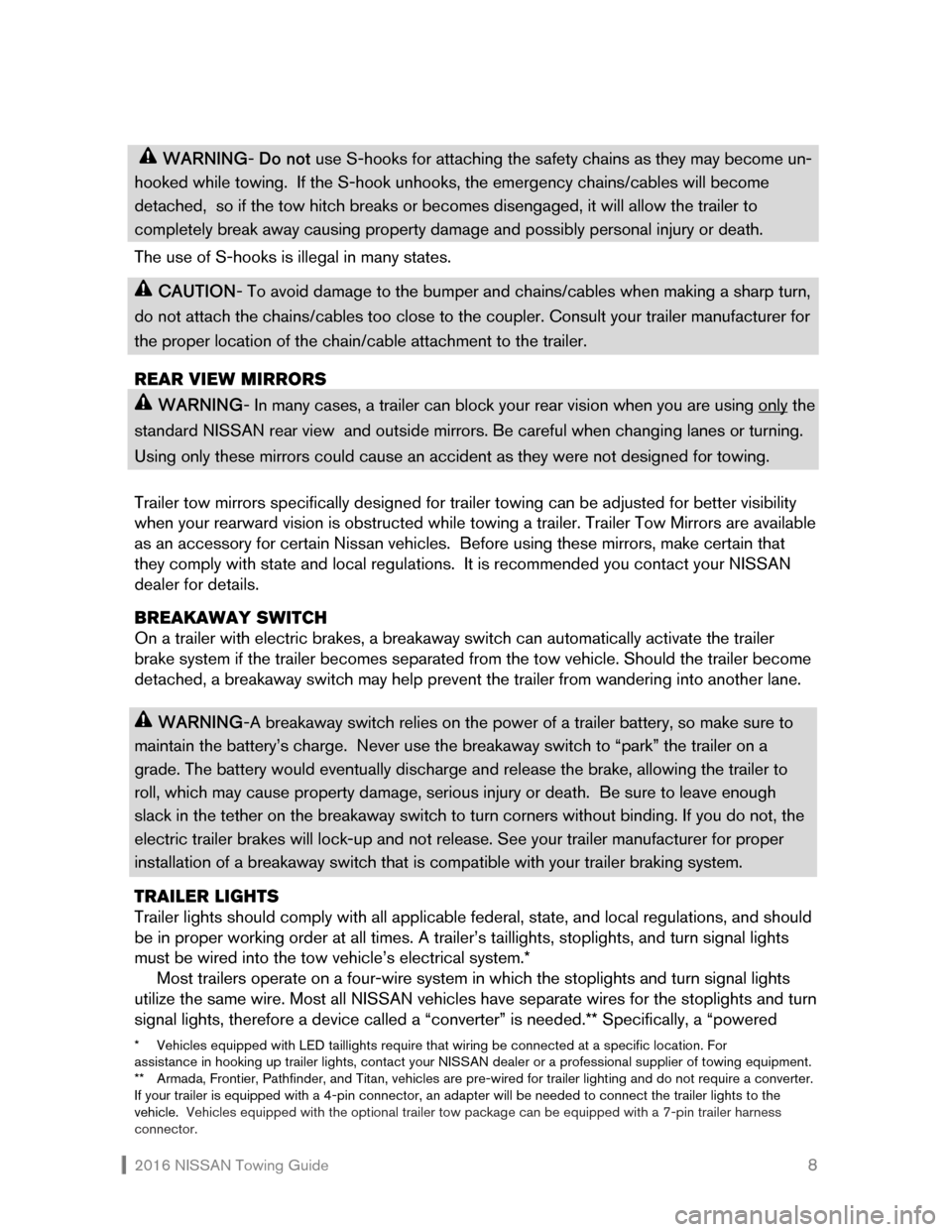
2016 NISSAN Towing Guide 8
WARNING- Do not use S-hooks for attaching the safety chains as they may become un-
hooked while towing. If the S-hook unhooks, the emergency chains/cables will become
detached, so if the tow hitch breaks or becomes disengaged, it will allow the trailer to
completely break away causing property damage and possibly personal injury or death.
The use of S-hooks is illegal in many states.
CAUTION- To avoid damage to the bumper and chains/cables when making a sharp turn,
do not attach the chains/cables too close to the coupler. Consult your trailer manufacturer for
the proper location of the chain/cable attachment to the trailer.
REAR VIEW MIRRORS
WARNING- In many cases, a trailer can block your rear vision when you are using only the
standard NISSAN rear view and outside mirrors. Be careful when changing lanes or turning.
Using only these mirrors could cause an accident as they were not designed for towing.
Trailer tow mirrors specifically designed for trailer towing can be adjusted for better visibility
when your rearward vision is obstructed while towing a trailer. Trailer Tow Mirrors are available
as an accessory for certain Nissan vehicles. Before using these mirrors, make certain that
they comply with state and local regulations. It is recommended you contact your NISSAN
dealer for details.
BREAKAWAY SWITCH
On a trailer with electric brakes, a breakaway switch can automatically activate the trailer
brake system if the trailer becomes separated from the tow vehicle. Should the trailer become
detached, a breakaway switch may help prevent the trailer from wandering into another lane.
WARNING-A breakaway switch relies on the power of a trailer battery, so make sure to
maintain the battery’s charge. Never use the breakaway switch to “park” the trailer on a
grade. The battery would eventually discharge and release the brake, allowing the trailer to
roll, which may cause property damage, serious injury or death. Be sure to leave enough
slack in the tether on the breakaway switch to turn corners without binding. If you do not, the
electric trailer brakes will lock-up and not release. See your trailer manufacturer for proper
installation of a breakaway switch that is compatible with your trailer braking system.
TRAILER LIGHTS
Trailer lights should comply with all applicable federal, state, and local regulations, and should
be in proper working order at all times. A trailer’s taillights, stoplights, and turn signal lights
must be wired into the tow vehicle’s electrical system.*
Most trailers operate on a four-wire system in which the stoplights and turn signal lights
utilize the same wire. Most all NISSAN vehicles have separate wires for the stoplights and turn
signal lights, therefore a device called a “converter” is needed.** Specifically, a “powered
* Vehicles equipped with LED taillights require that wiring be connected at a specific location. For
assistance in hooking up trailer lights, contact your NISSAN dealer or a professional supplier of towing equipment.
** Armada, Frontier, Pathfinder, and Titan, vehicles are pre-wired for trailer lighting and do not require a converter.
If your trailer is equipped with a 4-pin connector, an adapter will be needed to connect the trailer lights to the
vehicle. Vehicles equipped with the optional trailer tow package can be equipped with a 7-pin trailer harness
connector.
Page 12 of 27
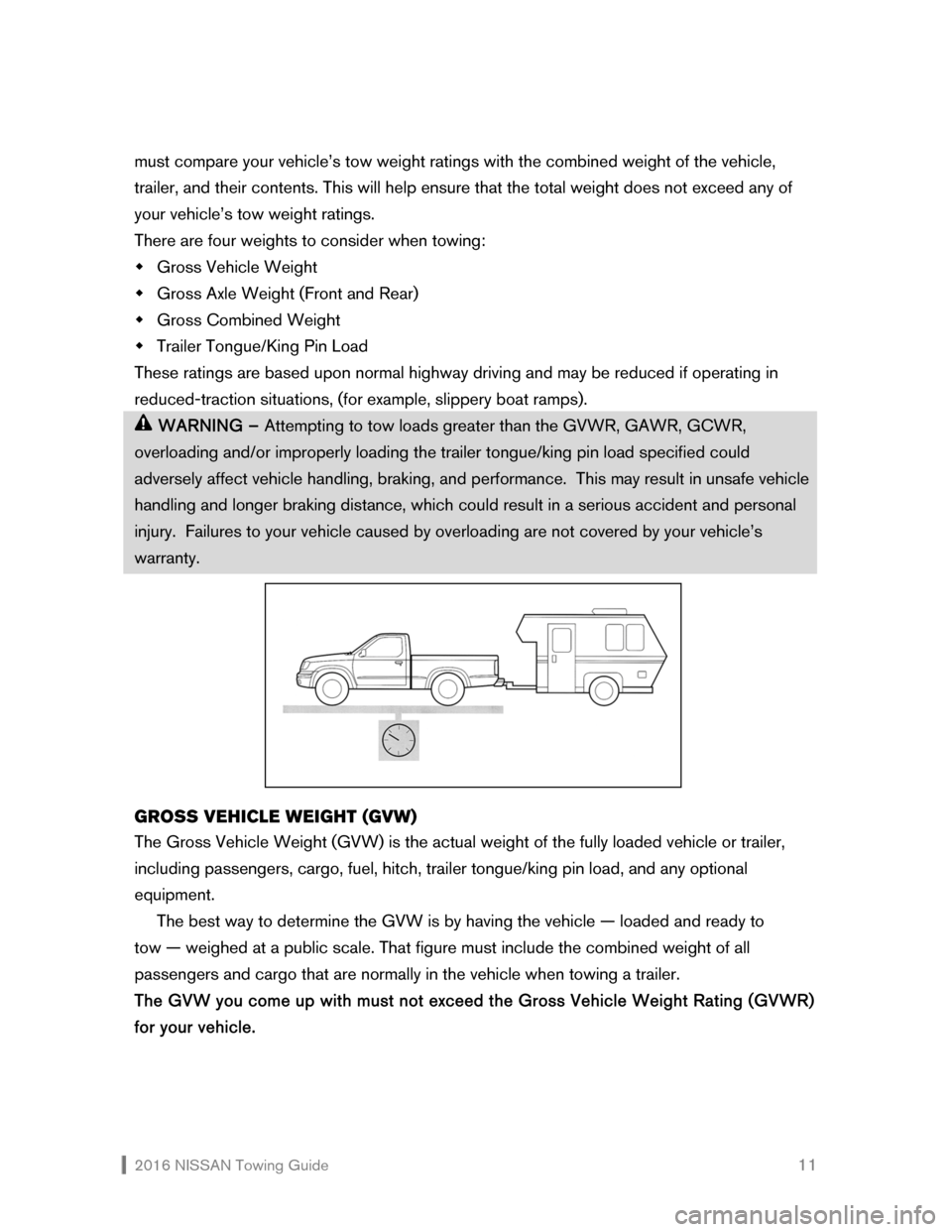
2016 NISSAN Towing Guide 11
must compare your vehicle’s tow weight ratings with the combined weight of the vehicle,
trailer, and their contents. This will help ensure that the total weight does not exceed any of
your vehicle’s tow weight ratings.
There are four weights to consider when towing:
Gross Vehicle Weight
Gross Axle Weight (Front and Rear)
Gross Combined Weight
Trailer Tongue/King Pin Load
These ratings are based upon normal highway driving and may be reduced if operating in
reduced-traction situations, (for example, slippery boat ramps).
WARNING – Attempting to tow loads greater than the GVWR, GAWR, GCWR,
overloading and/or improperly loading the trailer tongue/king pin load specified could
adversely affect vehicle handling, braking, and performance. This may result in unsafe vehicle
handling and longer braking distance, which could result in a serious accident and personal
injury. Failures to your vehicle caused by overloading are not covered by your vehicle’s
warranty.
GROSS VEHICLE WEIGHT (GVW)
The Gross Vehicle Weight (GVW) is the actual weight of the fully loaded vehicle or trailer,
including passengers, cargo, fuel, hitch, trailer tongue/king pin load, and any optional
equipment.
The best way to determine the GVW is by having the vehicle — loaded and ready to
tow — weighed at a public scale. That figure must include the combined weight of all
passengers and cargo that are normally in the vehicle when towing a trailer.
The GVW you come up with must not exceed the Gross Vehicle Weight Rating (GVWR)
for your vehicle.
Page 15 of 27
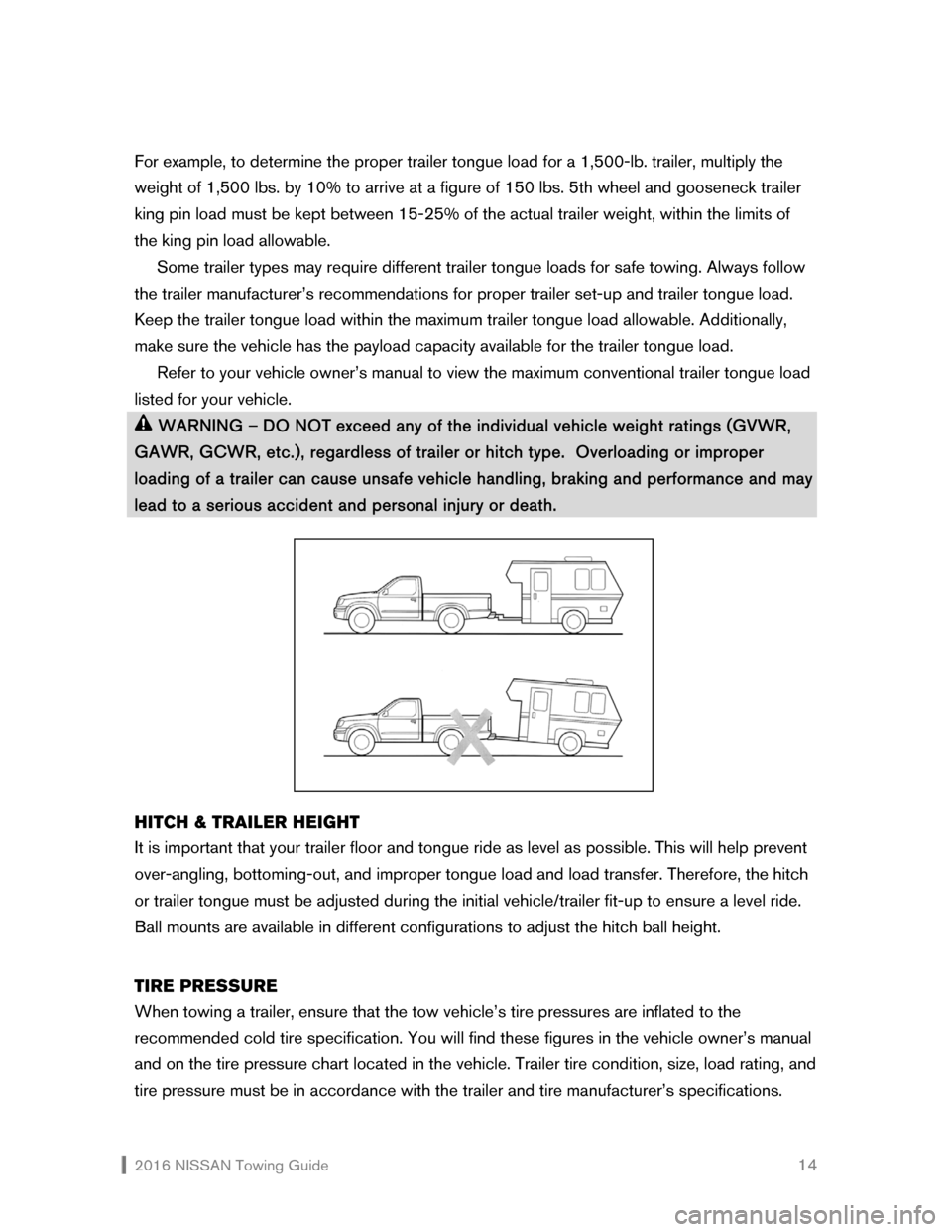
2016 NISSAN Towing Guide 14
For example, to determine the proper trailer tongue load for a 1,500-lb. trailer, multiply the
weight of 1,500 lbs. by 10% to arrive at a figure of 150 lbs. 5th wheel and gooseneck trailer
king pin load must be kept between 15-25% of the actual trailer weight, within the limits of
the king pin load allowable.
Some trailer types may require different trailer tongue loads for safe towing. Always follow
the trailer manufacturer’s recommendations for proper trailer set-up and trailer tongue load.
Keep the trailer tongue load within the maximum trailer tongue load allowable. Additionally,
make sure the vehicle has the payload capacity available for the trailer tongue load.
Refer to your vehicle owner’s manual to view the maximum conventional trailer tongue load
listed for your vehicle.
WARNING – DO NOT exceed any of the individual vehicle weight ratings (GVWR,
GAWR, GCWR, etc.), regardless of trailer or hitch type. Overloading or improper
loading of a trailer can cause unsafe vehicle handling, braking and performance and may
lead to a serious accident and personal injury or death.
HITCH & TRAILER HEIGHT
It is important that your trailer floor and tongue ride as level as possible. This will help prevent
over-angling, bottoming-out, and improper tongue load and load transfer. Therefore, the hitch
or trailer tongue must be adjusted during the initial vehicle/trailer fit-up to ensure a level ride.
Ball mounts are available in different configurations to adjust the hitch ball height.
TIRE PRESSURE
When towing a trailer, ensure that the tow vehicle’s tire pressures are inflated to the
recommended cold tire specification. You will find these figures in the vehicle owner’s manual
and on the tire pressure chart located in the vehicle. Trailer tire condition, size, load rating, and
tire pressure must be in accordance with the trailer and tire manufacturer’s specifications.